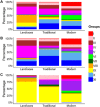Worldwide phylogeography and history of wheat genetic diversity
- PMID: 31149630
- PMCID: PMC6541461
- DOI: 10.1126/sciadv.aav0536
Worldwide phylogeography and history of wheat genetic diversity
Abstract
Since its domestication in the Fertile Crescent ~8000 to 10,000 years ago, wheat has undergone a complex history of spread, adaptation, and selection. To get better insights into the wheat phylogeography and genetic diversity, we describe allele distribution through time using a set of 4506 landraces and cultivars originating from 105 different countries genotyped with a high-density single-nucleotide polymorphism array. Although the genetic structure of landraces is collinear to ancient human migration roads, we observe a reshuffling through time, related to breeding programs, with the appearance of new alleles enriched with structural variations that may be the signature of introgressions from wild relatives after 1960.
Figures





References
-
- Heun M., Schäfer-Pregl R., Klawan D., Castagna R., Accerbi M., Borghi B., Salamini F., Site of einkorn wheat domestication identified by DNA fingerprinting. Science 278, 1312–1314 (1997).
-
- Salamini F., Ozkan H., Brandolini A., Schäfer-Pregl R., Martin W., Genetics and geography of wild cereal domestication in the Near East. Nat. Rev. Genet. 3, 429–441 (2002). - PubMed
-
- A. P. Bonjean, W. J. Angus, The World Wheat Book: A History of Wheat Breeding (Lavoisier Publishing Inc., 2001).
-
- Baenziger P. S., Russell W. K., Graef G. L., Campbell B. T., Improving lives. Crop. Sci. 46, 2230–2244 (2006).
-
- Balfourier F., Roussel V., Strelchenko P., Exbrayat-Vinson F., Sourdille P., Boutet G., Koenig J., Ravel C., Mitrofanova O., Beckert M., Charmet G., A worldwide bread wheat core collection arrayed in a 384-well plate. Theor. Appl. Genet. 114, 1265–1275 (2007). - PubMed
Publication types
MeSH terms
LinkOut - more resources
Full Text Sources

